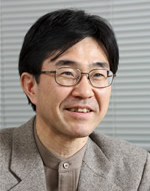2010/05/10
A new paradigm to connect continuous and discrete approaches of optimization problems
Professor Kazuo Murota
(Department of Mathematical Informatics)

Professor Murota has cut to the heart of optimization problems with “mathematical eyes” and advocated the new theory of “Discrete Convex Analysis.” The structure of the discrete world has then become more comprehensible by treating “analog(= continuous)” and “digital(= discrete)” aspects of the mathematical world in a unified way and on an equal footing.
Optimization means maximization of profit or minimization of cost. For example , it aims at constructing strategies to reach a destination in a shortest way. One way to approach that is “Continuous Optimization” based on continuously distributed values and another is “Discrete Optimization” that deals with discontinuously distributed (discrete) values.
The theory of “Convex Analysis” is positioned at the core of the continuous optimization world. It was common knowledge in continuous optimization that things look clearer if seen from both sides------front and back (duality), and Professor Murota thought that continuous and discrete optimization should be discussed in the same arena rather than looking at them separately. He realized that inexplicable phenomena in the discrete world might become explicable if convex analysis perspectives are brought into the discrete world.
On December 3rd 1994 when Professor Murota was doing research on matrix structure, he felt that he saw “the germ of discrete convexity.” The germ burgeoned to establish the new theoretical system called “Discrete Convex Analysis”, which can explain continuous and discrete optimization in a unified way based on duality, i.e., on the concept that “things look clearer if seen from front and back.” This theory indicated that several fundamental phenomena in electric circuits, operations research, game theory, mathematical economics, and physics follow a common logic. It is, however, not yet broadly applicable and his activities as a Discrete Convex theory evangelist continue.
Professor Murota says “I find creating a game more interesting than solving a game (or an unsolved problem) created by others.” It may be because of his nature as a mathematical-engineering researcher who wears two hats (PhDs) of engineering and science.